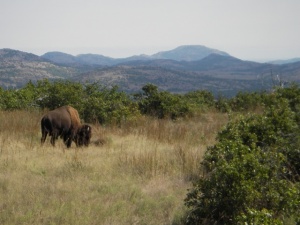When I was a young boy growing up in Lawton, Oklahoma, my dad would take me hiking quite a bit in the Wichita Mountains Wildlife Refuge just minutes from our home. It was on our hikes in those mountains that my love for nature and the outdoors developed, and to this day I feel that the Wichita Mountains (along with the Olympic Mountains of Washington state where my grandparents retired and lived for 23 years) are my spiritual home.
On one of our first hikes in the Wichitas as we were looking at a herd of majestic bison, my father told me the story about how these animals once numbered in the millions, with herds stretching across the plains as far as the eye could see, but they were hunted to the point of near extinction during the westward expansion of European settlers with their bodies left to rot by the thousands on the prairie. This story was one of my first glimpses into the capacity for evil on the part of human persons. I had a similar early glimpse of massive human moral failing when I saw the vast tracks of clear cuts in the forests of the otherwise beautiful Olympic Peninsula in my summer visits with my maternal grandparents in my other spiritual home.
On that hike in the Wichitas, my father went on to tell me that at the point when the bison were closest to extinction, a small number of bison (15 at first) were transported to the Wichita mountains by train from the Bronx Zoo in 1907 and that the hundreds of bison that now live in the refuge and the thousands that are now in existence are alive because of the efforts to save them and bring them back to the Great Plains where they belong. My father also told me the story of the Comanche Chief, Quanah Parker, who was present for the return of the bison on that train from New York. Though I did not realize it as much when I was a young boy, this was an important part of the story given that the slaughter of the bison was part of an even greater evil, the genocide of native peoples who were dependent on the bison for their way of life, something I learned over time later in life.
This early memory is significant for me. It was one of the first times that I became aware of the very bad things we humans are capable of doing. It was almost unbelievable to me that humans could do such a thing to such an animal. However, it was not lost on me that at the point when the bison were almost totally lost to extinction, human commitment and action were able to bring the bison back from the brink. There was great moral failing and even evil in the story, but there was also a narrative of hope that humans can bring life and not just death into the world.
The dual aspects of awareness of both evil and the capacity for goodness in this story have forever stayed with me. Since my time as a boy on this hike in the Wichitas, I have seen too many human failings (including my own) to be an optimist about the future, but I have also seen too many wonderful acts of life-giving love and compassion to be a pessimist. I am a meliorist. I believe we can make the world a better place through hard work and shared commitment, but there is no guarantee. It is up to us. It is our responsibility.

Even though your writing on Meliorism is almost a year old, I really enjoyed reading it. I am so gratified that a Lawton Oklahoma native can make such a meaningful contribution to our culture. The Bison is such a majestic creature. A portion of God’s beauty that surrounds us every day.
[…] 4. Meliorism […]